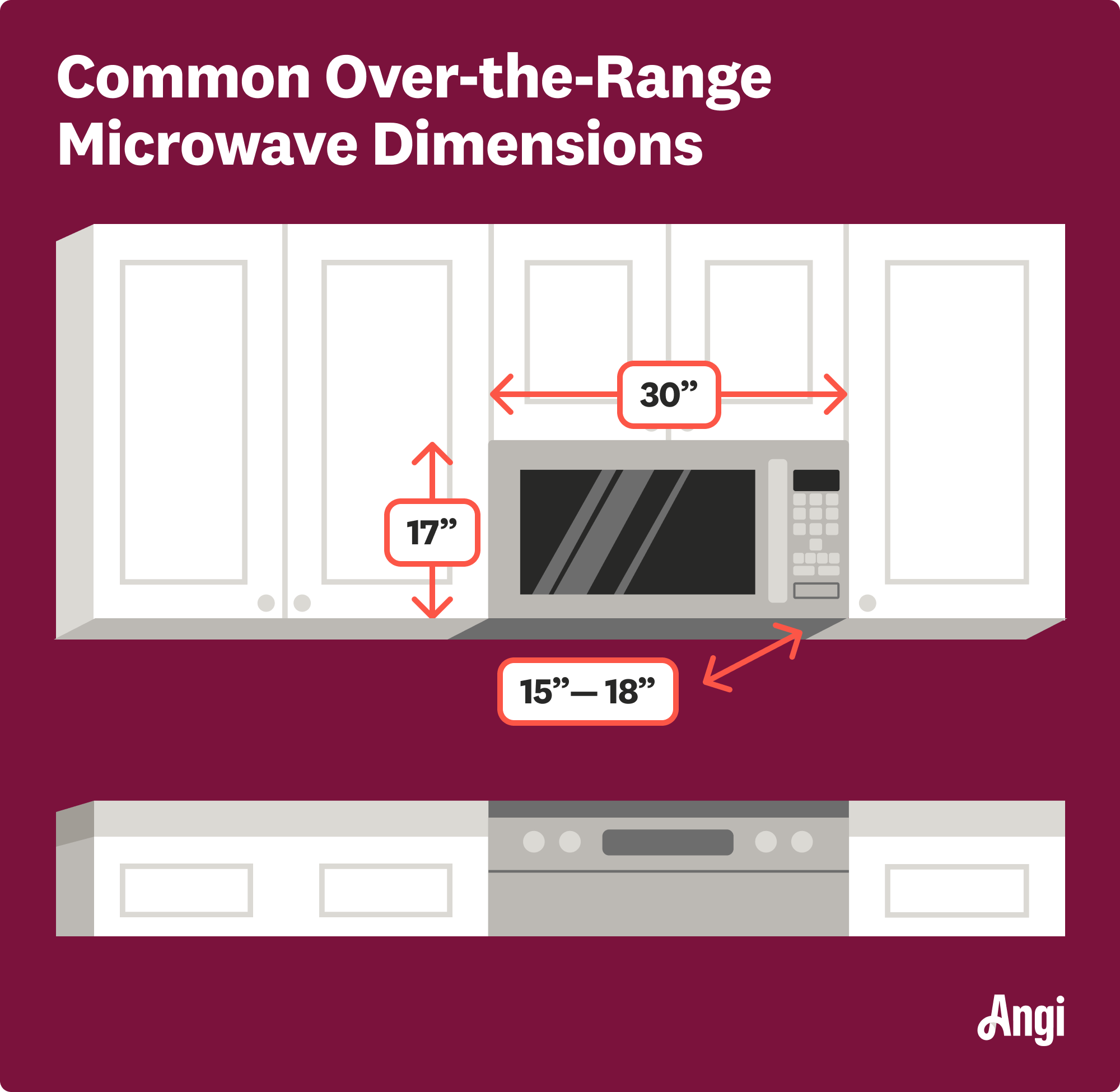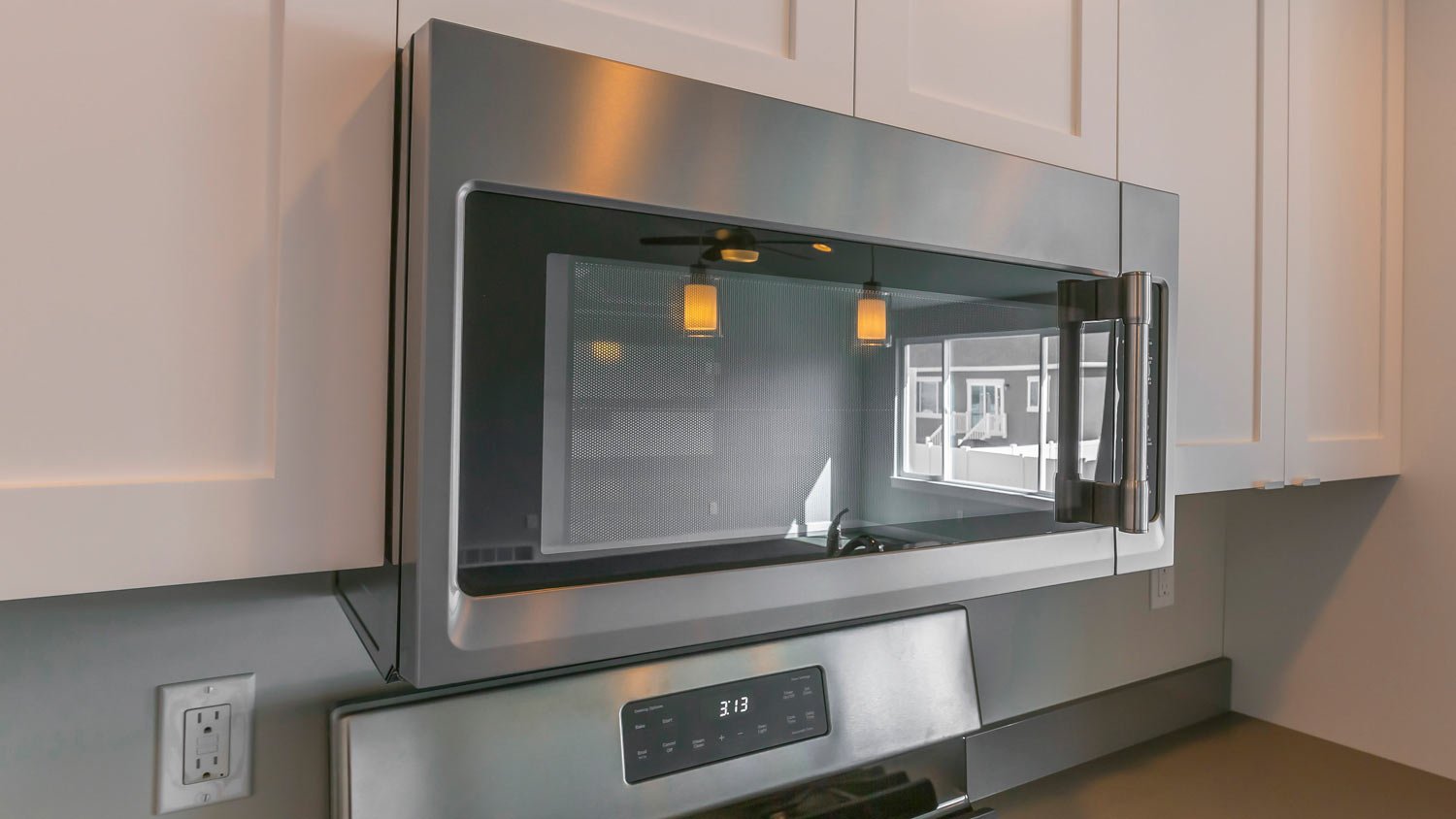
If your refrigerator has been damaged, refrigerator door dent repair cost will vary based on the imperfection's size, depth, and location. Use our guide to estimate how much you'll spend on refrigerator dent repair.
Time to pull out your trusty tape measure


Over-the-range microwaves are usually around 17 inches in height.
You can hold a tape measure against the side of your microwave to determine its height.
There should be at least 30 inches of clearance between the range and the cabinet above the microwave.
You should have at least 13 inches of space between the cooktop and the bottom of the microwave.
Over-the-range (OTR) microwaves may be a sleeker alternative to traditional countertop models, but they’re also much harder to install. Even if you’re replacing an existing OTR microwave, you’ll need to take a few different measurements to make sure your new unit will fit in your kitchen. So, how do you measure the height of an over-the-range microwave, exactly? Let’s walk through it.

As its name suggests, an over-the-range microwave is mounted above your stove or range. Many people install this type of microwave to save counter space, but it offers other benefits, too. Specifically, OTR microwaves have vents to capture smoke and odors from your cooktop. They have built-in lights as well, which is particularly useful in kitchens with limited natural lighting.
When it comes to OTR microwaves, there are two kinds of height measurements to keep in mind: the height of the microwave itself and the clearance space between the microwave and your cooktop.
Over-the-range microwaves are typically around 17 inches in height, but there are also low-profile models that are about 10 inches tall. To measure yours, hold a tape measure against one of the microwave’s vertical sides.
When installing an OTR microwave, you should maintain at least 30 inches of clearance between the top of the cooking surface and the bottom of the cabinet above the microwave. You can measure this distance by running a tape measure from the tallest point of the cooktop to the underside of the upper cabinet. Be sure to do this before you buy a new microwave so you understand the maximum microwave height for your space.
Once the microwave is in place, there should be at least 13 inches between the cooking surface and the underside of the microwave. This will give you enough room to use your stove comfortably and safely. To determine the height of this area, subtract the height of your new microwave from the total clearance space that you measured previously. If you’re left with 13 inches or more, there’s enough room for the microwave.
Again, make sure to run these calculations before you purchase a microwave; otherwise, you could get stuck with an appliance that’s too tall for your space. If you aren’t confident in your measuring skills, it might be better to call a professional microwave installer near you.

In addition to height, there are a few other size factors to consider when shopping for a new over-the-range microwave.
For starters, you’ll need to know the width of the cutout—which is the area where the microwave will go—in order to buy the right size microwave. To do this, hold a tape measure across the open space of the cutout, stretching it from the vertical edge of one cabinet to the edge of the opposite cabinet.
Fortunately, cutout widths typically align with standard microwave sizes. For reference, OTR microwaves are typically around 30 inches in width, but some models may be bigger or smaller.
It’s also important to measure the depth of the cutout. You can do this by measuring from the wall to the outer edge of the cabinet that will sit above the microwave.
If you want your microwave to fit that space snugly, choose a model with the same depth as the cutout. You can also pick a unit that’s deeper than the cutout, but just be aware that it will jut out from your cabinets. When the microwave door is closed, most over-the-range microwaves are 15 to 18 inches deep.
I used Top Roof to repair our leaky shingle roof and had a great experience with them. Top Roof and his team were very nice to deal with, performed quality work in a timely fashion, and at a very competitive price. I appreciate as a customer. I would call again for any roofing needs and...
Did some repairs to the roof. The roof had some water damage. He did a great job. The price was reasonable. He was easy to work with. He does a really good job. If I have any other work, I call him. They clean up after themselves really well.
I couldn't have been more pleased with the work performed by ACR Group. Jim, his brother Michael and crew were fantastic! They did a great job. The debris from the repairs and cleaning of the gutters was nowhere to be seen. Every day the site was as clean as when they arrived and the final...
the plumber did the work fairly easy took him less than 5mins. However the plumber never gave cost of service before beginning inspite of the fact when i set the appt that was my first request an estimate. i was told it was $39 for them to come out and at that time id be told cost of repair....
very professional very highly skilled in drywall repair
I own a 2011 Dodge Grand Caravan that I use for my business. Dropped my car at mr transmission on July 6, 2015, after he diagnosed my car, he Initially quoted me $598 flat for the labor and he said I only need snap ring and wave plates for an additional $75 for parts, he called me on July 7,...
From average costs to expert advice, get all the answers you need to get your job done.

If your refrigerator has been damaged, refrigerator door dent repair cost will vary based on the imperfection's size, depth, and location. Use our guide to estimate how much you'll spend on refrigerator dent repair.

Dryer repair costs as little as $10, but sometimes, replacing your dryer is more cost-effective. But if you have to make repairs, here’s how much it’ll cost.

Get transparent refrigerator repair cost info. Learn what impacts price, compare repair vs. replacement, and find ways to save on your fridge repair.

Did you leave the gas on? If you went out and forgot to turn off the stove, don’t panic. Instead, remain calm and follow a few basic steps.

You have options for disposing of old appliances, like your refrigerator, freezer, washer or dryer. Use this guide to learn what to do with old appliances.

You can usually unclog your dishwasher by cleaning the filter and using a DIY solution to clear the drain hose. Learn more with this step-by-step guide.